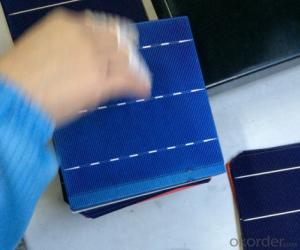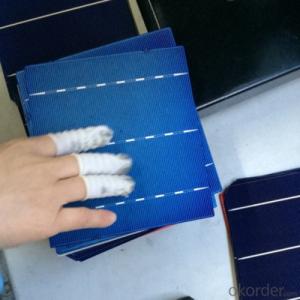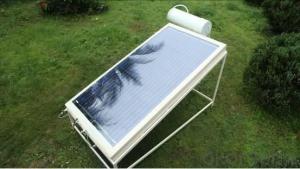Poly 3BB 4BB Solar Cells with Low Price 156*156mm
- Loading Port:
- Shanghai
- Payment Terms:
- TT or LC
- Min Order Qty:
- 30000 pc
- Supply Capability:
- 3000000 pc/month
OKorder Service Pledge
OKorder Financial Service
You Might Also Like
Product description
Poly Solar Cells 156*156mm B Grade Low Price 3BB 4BB
A solar cell, or photovoltaic cell, is an electrical device that converts the energy of light directly into electricity by the photovoltaic effect, which is a physical and chemical phenomenon.[1] It is a form of photoelectric cell, defined as a device whose electrical characteristics, such as current, voltage, or resistance, vary when exposed to light. Solar cells are the building blocks of photovoltaic modules, otherwise known as solar panels.
Solar cells are described as being photovoltaic irrespective of whether the source is sunlight or an artificial light. They are used as a photodetector (for example infrared detectors), detecting light or other electromagnetic radiation near the visible range, or measuring light intensity.
In contrast, a solar thermal collector supplies heat by absorbing sunlight, for the purpose of either direct heating or indirect electrical power generation from heat. A "photoelectrolytic cell" (photoelectrochemical cell), on the other hand, refers either to a type of photovoltaic cell (like that developed by Edmond Becquerel and modern dye-sensitized solar cells), or to a device that splits water directly into hydrogen and oxygen using only solar illumination.
Advantage Of Poly Solar Cell 4BB 3BB
1: High quality cell, Level B cell (14%—17.5%)
2.Dimensione:156*156mm Diagonal:200mm
3: Qualified certification: TUV,CE certification.
4: Warranty: five years for whole unit
Usage/Application Of Poly Solar Cell 4BB 3BB
1.The absorption of light, generating either electron-hole pairs or excitons.
2.The separation of charge carriers of opposite types.
3.The separate extraction of those carriers to an external circuit.
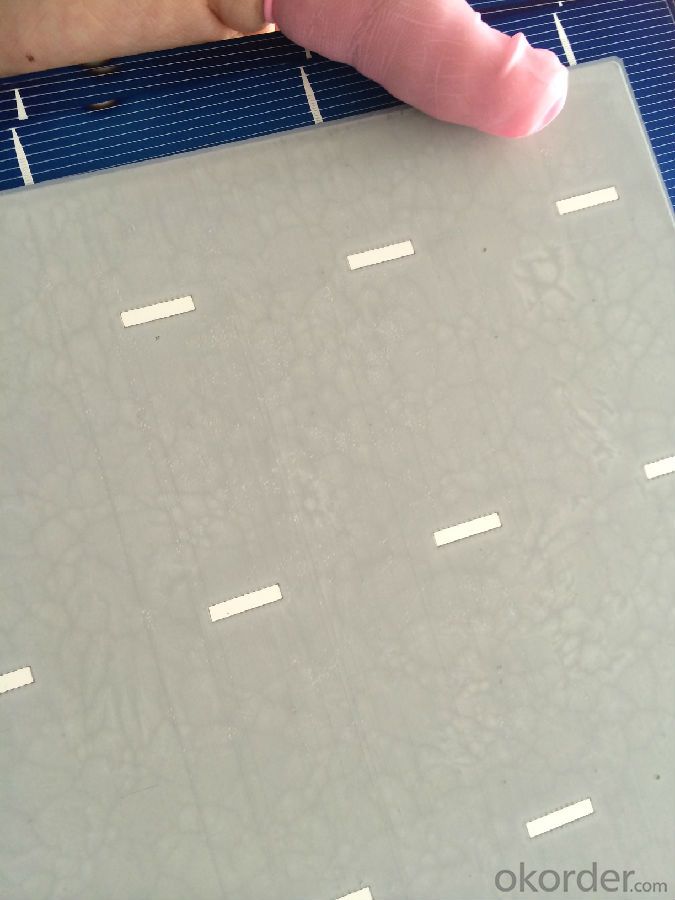
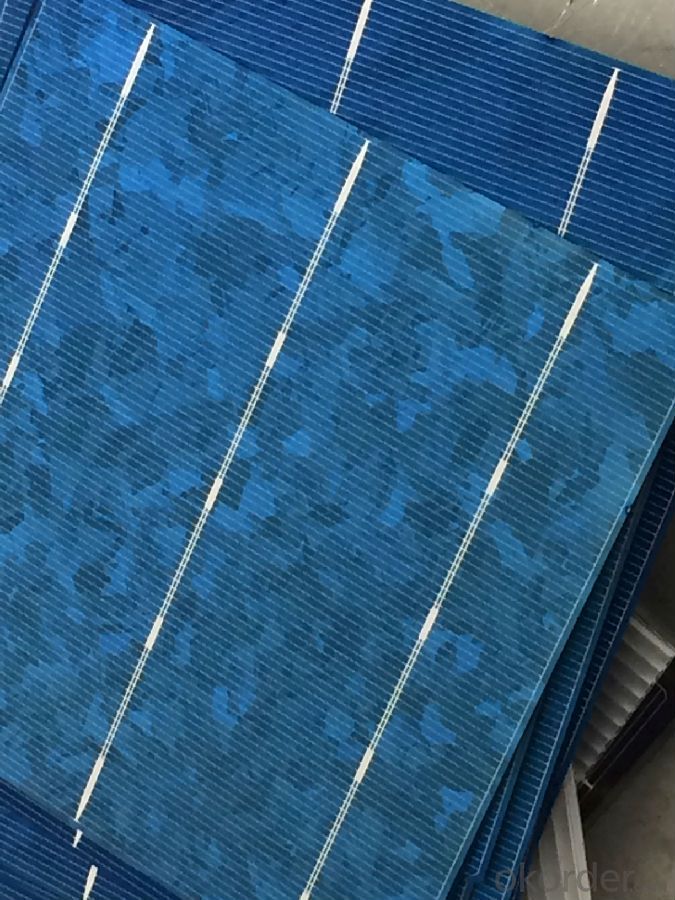
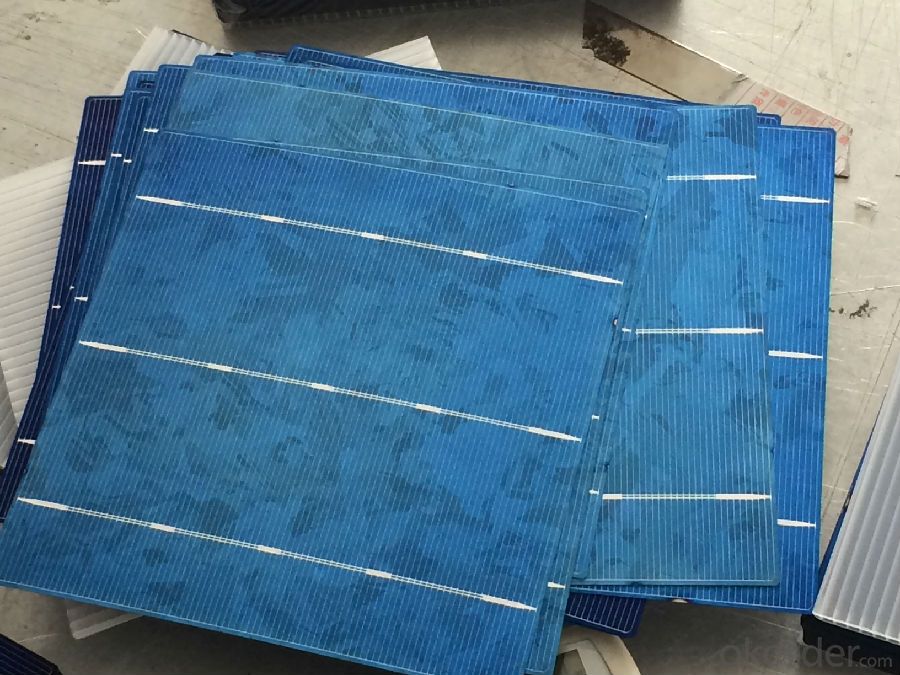
Electrical Characteristic
Efficiency (%) | Pmpp (W) | Umpp (V) | Impp (A) | Uoc (V) | Isc (A) | FF (%) |
17.25 | 4.197 | 0.524 | 7.992 | 0.62 | 8.458 | 80.03% |
17 | 4.137 | 0.524 | 7.876 | 0.619 | 8.353 | 80.01% |
16.75 | 4.076 | 0.522 | 7.81 | 0.617 | 8.286 | 79.73% |
16.5 | 4.015 | 0.518 | 7.746 | 0.613 | 8.215 | 79.73 |
16.25 | 3.955 | 0.515 | 7.683 | 0.61 | 8.144 | 79.61% |
16 | 3.894 | 0.512 | 7.613 | 0.608 | 8.075 | 79.31% |
15.75 | 3.833 | 0.51 | 7.534 | 0.605 | 8.058 | 78.62% |
15.5 | 3.772 | 0.508 | 7.453 | 0.604 | 8.02 | 77.87% |
15.25 | 3.771 | 0.505 | 7.35 | 0.604 | 9.997 | 76.83% |
15 | 3.65 | 0.503 | 7.271 | 0.604 | 7.989 | 75.64% |
14.5 | 3.529 | 0.499 | 7.067 | 0.604 | 7.988 | 73.14% |
14 | 3.407 | 0.499 | 6.833 | 0.604 | 7.833 | 72.01% |
Intensity Dependence
Intensity [W/m2] | Isc× [mA] | Voc× [mV] |
1000 | 1.00 | 1.000 |
900 | 0.90 | 0.989 |
500 | 0.50 | 0.963 |
300 | 0.30 | 0.939 |
200 | 0.20 | 0.920 |
Packaging & Delivery Of Poly Solar Cell 156mm | |
Packaging Detai | Packaging Detail:Export Carton and Pallet or under customer request. |
Delivery Detail:10-20days | |
FAQ
Q:What price for each watt?
A:It depends on the quantity, delivery date and payment terms
Q:What is your warranty system?
A:Our Solar cells performance guarantees for 25 years
Q:How do you pack your products?
A:We have rich experience on how to pack thecells to make sure the safety on shipment when it arrives at the destination.
Brief introduction of 4bb solar cell
4bb solar cells through the photoelectric effect or photochemical effect directly convert light into electrical energy, which makes use of the photoelectric conversion principle of solar radiation through the semiconductor material electrical energy transformed into a device; the photoelectric conversion process is usually called "photovoltaic hit "affect, therefore, solar cells, also known as" photovoltaic cells.
Working principle of 4bb solar cell
Foundation of working principle of 4bb solar cell is the "photovoltaic" effect semiconductor PN junction. The so-called photovoltaic effect, simply put, is that when the object is exposed to light, its charge distribution in vivo to produce an effect of EMF and current changes. In gases, liquids and solids can produce this effect, but in solid, especially in the semiconductor, solar energy is converted to electrical energy efficiency is particularly high, so the semiconductor photoelectric effect aroused special attention, the most studied, and invention of manufacturing a semiconductor solar cells.
When sun lights PN junction, the electrons in the semiconductor due to the availability of light energy and release electrons, and accordingly will produce electron - hole pairs, and the role of the barrier electric field, electrons are driven to the N-type region, holes are driven to the P-type region so that the region has a surplus of electrons N, P region has excess holes; so in the vicinity of the PN junction formed with the barrier electric field in the opposite direction of photo-generated electric field. Light green part of the field of offset barrier electric field, the rest of the P-type region is positively charged, N-type region is negatively charged; so he makes the force N region and a thin layer of P zone between the generation, namely "photovoltaic" electromotive force. When the external circuit is turned on, there will be power output.
This is the basic principle of the PN junction contact silicon 4bb solar cell power generation. If the dozens, hundreds of solar cells in series, in parallel become encapsulated solar cell module in the sunlight irradiation, the power can be obtained with a certain power output

- Q:Can solar cells be used in healthcare facilities?
- Yes, solar cells can be used in healthcare facilities. They can be employed to generate electricity, which can power medical equipment, lighting, and other essential systems in healthcare facilities. Solar energy can help reduce reliance on the conventional power grid, providing a sustainable and cost-effective source of electricity for healthcare facilities, especially in remote or off-grid areas. Additionally, solar cells can contribute to reducing carbon emissions and promoting environmental sustainability in the healthcare sector.
- Q:Can solar cells be used in public infrastructure projects?
- Yes, solar cells can be used in public infrastructure projects. Solar cells can be integrated into various infrastructure elements such as street lights, bus stops, parking meters, and even road surfaces to generate electricity from sunlight. This sustainable energy source can help reduce reliance on traditional power grids, lower carbon emissions, and promote renewable energy use in public spaces.
- Q:Can solar cells be used for off-grid power systems?
- Yes, solar cells can definitely be used for off-grid power systems. Solar cells, also known as photovoltaic cells, convert sunlight directly into electricity and can be used to generate power in remote locations that are not connected to the main power grid. These cells can be installed on rooftops, in open fields, or even on portable devices to generate electricity for various off-grid applications such as powering homes, cabins, or other remote facilities.
- Q:How to get high voltage, high current output of solar cells
- Using 880 0.5 volt 5 amp output of the panel, 440 in series as the first group, and then get a second group, then the two groups in parallel, you can get 220 volts 10 amps output
- Q:What is the role of bypass diodes in solar cell systems?
- The role of bypass diodes in solar cell systems is to minimize the impact of shading or partial module failure. They allow current to bypass the shaded or malfunctioning cells, preventing them from reducing the overall performance of the system.
- Q:Can solar cells be used in commercial buildings?
- Yes, solar cells can definitely be used in commercial buildings. In fact, the use of solar cells in commercial buildings is becoming increasingly popular as it offers several benefits such as reduced energy costs, environmental sustainability, and a positive brand image. With advancements in technology, solar cells can now be integrated into the design of buildings, ensuring seamless integration and aesthetic appeal. Additionally, various financing options and government incentives make solar installations financially feasible for commercial buildings, further encouraging their adoption.
- Q:How do solar cells perform in areas with high levels of industrial emissions?
- Solar cells can still function effectively in areas with high levels of industrial emissions. While industrial emissions can potentially increase air pollution and reduce sunlight, solar cells are designed to convert both direct and indirect sunlight into electricity. Though the efficiency of solar cells might be slightly reduced due to decreased sunlight availability, proper maintenance and cleaning can help mitigate any potential negative impact on their performance.
- Q:Are solar cells affected by shade?
- Yes, solar cells are affected by shade. When solar cells are partially shaded, it reduces their efficiency and overall power output. Shading can create hotspots on the shaded cells, causing them to generate less electricity and potentially damage the cells. Therefore, it is important to ensure that solar panels are installed in areas with minimal shade to maximize their performance.
- Q:What is the difference between solar cells and solar panels?
- Solar cells and solar panels are often used interchangeably, but there is a slight difference between the two. Solar cells, also known as photovoltaic cells, are the individual units that convert sunlight into electricity through the photovoltaic effect. On the other hand, solar panels are made up of multiple solar cells interconnected to form a larger module, which is capable of generating a higher amount of electricity. In simple terms, solar cells are the building blocks, whereas solar panels are the final product that harnesses solar energy for power generation.
- Q:Can solar cells be used to power outdoor signage?
- Yes, solar cells can be used to power outdoor signage. Solar panels or cells can be installed on or near the signage to harness sunlight and convert it into electricity. This renewable energy source can provide a sustainable and cost-effective solution for powering outdoor signage, reducing dependence on traditional power sources.
1. Manufacturer Overview |
|
|---|---|
| Location | |
| Year Established | |
| Annual Output Value | |
| Main Markets | |
| Company Certifications | |
2. Manufacturer Certificates |
|
|---|---|
| a) Certification Name | |
| Range | |
| Reference | |
| Validity Period | |
3. Manufacturer Capability |
|
|---|---|
| a)Trade Capacity | |
| Nearest Port | |
| Export Percentage | |
| No.of Employees in Trade Department | |
| Language Spoken: | |
| b)Factory Information | |
| Factory Size: | |
| No. of Production Lines | |
| Contract Manufacturing | |
| Product Price Range | |
Send your message to us
Poly 3BB 4BB Solar Cells with Low Price 156*156mm
- Loading Port:
- Shanghai
- Payment Terms:
- TT or LC
- Min Order Qty:
- 30000 pc
- Supply Capability:
- 3000000 pc/month
OKorder Service Pledge
OKorder Financial Service
Similar products
New products
Hot products
Hot Searches
Related keywords

